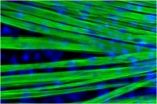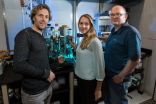Ergonomics in Design special issue 'Combating the Sedentary Workplace' just released
2015-08-03
(Press-News.org) Recent research has shown that the more time employees spend in their chairs, the more likely they are to develop serious health problems such as diabetes, heart disease, and obesity. The July special issue of Ergonomics in Design examines the health and safety effects of the sedentary workplace, the pros and cons of alternatives to sitting at work (for example, sit-stand and treadmill workstations, ball chairs), and proposed workplace design solutions. The full text of the issue, guest edited by Jack Dennerlein, is now available online and may be found at http://erg.sagepub.com/content/current.
"With the recent increase in attention to sedentary work and its effects on worker health, there has been a push to change the design of the workplace in order to provide opportunities to reduce the amount of time workers are sedentary," says Dennerlein. "These design changes need to be guided as best as they can by evidence-based and best practice approaches to protecting worker safety and health to ensure these changes actually improve well-being and performance."
The special issue contains these articles:
"Is Sitting Too Much Bad for Your Health?" - Alternatives such as sit-stand and treadmill workstations can reduce sitting time at work if designed and implemented correctly.
"Stand Up and Move; Your Musculoskeletal Health Depends on It" - An examination of dynamic workstations shows some physical benefits, but often at the expense of productivity.
"A Physiological Perspective on Treadmill and Sit-to-Stand Workstations" - Studies suggest that light-intensity activity from using treadmill and sit-to-stand workstations may help to prevent the onset or progression of poor cardio-metabolic health.
"Is Standing the Solution to Sedentary Office Work?" - A suggested ratio for alternating sitting and standing, along with training on use of sit-stand workstations, may reduce the incidence of low-back pain.
"Research Needs for and Barriers to Use of Treadmill Workstations" - Consideration of usability, comfort, safety, and work productivity should be supplemented by examination of psychosocial factors in determining if treadmill workstations will be effective.
"Office Ergonomics Driven by Contextual Design" - Observation of 10 office workers resulted in design recommendations aimed at reducing sitting time, including office design, social interaction, and education about the hazards of prolonged sitting.
"Design Recommendations for Active Workplaces" - Workplace program design solutions need to be informed by evidence of effectiveness, best-practice design dimensions, and recognition that the workplace is a complex social system.
"The research presented in this special issue identifies key factors that can facilitate the success of new approaches to office design and discusses specific barriers and limitations that can inhibit this success," adds Dennerlein.
INFORMATION:
To obtain copies of articles for media reporting purposes, contact HFES Communications Associate Cara Quinlan (310/394-1811; cara@hfes.org) or Communications Director Lois Smith (310/394-1811; lois@hfes.org).
The Human Factors and Ergonomics Society is the world's largest scientific association for human factors/ergonomics professionals, with more than 4,800 members globally. HFES members include psychologists and other scientists, designers, and engineers, all of whom have a common interest in designing systems and equipment to be safe and effective for the people who operate and maintain them. "Human Factors and Ergonomics: People-Friendly Design Through Science and Engineering"
Plan to attend the 2015 International Annual Meeting, to be held October 26-30 in Los Angeles.
ELSE PRESS RELEASES FROM THIS DATE:
2015-08-03
Scientists from the University of Leeds have uncovered further evidence that the protective buffers at the ends of chromosomes - known as telomeres - are fundamental to the understanding of the deadliest form of skin cancer, melanoma.
A team of international researchers, co-led by Dr Mark Iles from the University's School of Medicine and St James's University Hospital in Leeds, has uncovered five new common genetic risk factors for melanoma. They have also confirmed two others previously suspected to be risk factors.
Dr Iles said: "This research establishes further ...
2015-08-03
Researchers led by the University of Cambridge have found the earliest example of reproduction in a complex organism. Their new study has found that some organisms known as rangeomorphs, which lived 565 million years ago, reproduced by taking a joint approach: they first sent out an 'advance party' to settle in a new area, followed by rapid colonisation of the new neighbourhood. The results, reported today in the journal Nature, could aid in revealing the origins of our modern marine environment.
Using statistical techniques to assess the distribution of populations ...
2015-08-03
High-dose vitamin D supplementation in postmenopausal women was not associated with beneficial effects on bone mineral density, muscle function, muscle mass or falls, according to the results of a randomized clinical trial published online by JAMA Internal Medicine.
Low levels of vitamin D contribute to osteoporosis because of decreased total fractional calcium absorption (TFCA) and nearly half of postmenopausal women sustain an osteoporotic fracture. However, experts disagree on the optimal vitamin D level for skeletal health. Some experts contend that optimal serum ...
2015-08-03
A recently discovered family of small RNA molecules, some of which have been implicated in cancer progression, has just gotten much larger thanks to a new RNA sequencing technique developed by researchers at UC Santa Cruz.
The technique, described in a paper published August 3 in Nature Methods, provides sensitive detection of small RNAs that are chemically modified (methylated) after being transcribed from the genome. The researchers used the technique to reveal an abundance of modified fragments derived from transfer RNA molecules in both yeast cells and human cells.
"Transfer ...
2015-08-03
Skeletal muscle is one of the most abundant tissue types in the human body, but has proven difficult to produce in large quantities in the lab. Unlike other cell types, such as heart cells, neurons and cells found in the gut, previous attempts to efficiently and accurately derive muscle cells from pre-cursor cells or culture have not been fruitful. In a new study published this week in Nature Biotechnology, investigators from Brigham and Women's Hospital (BWH) report that by identifying and mimicking important developmental cues, they have been able to drive cells to grow ...
2015-08-03
LA JOLLA--T cells are the guardians of our bodies: they constantly search for harmful invaders and diseased cells, ready to swarm and kill off any threats. A better understanding of these watchful sentries could allow scientists to boost the immune response against evasive dangers (e.g., cancer or infections), or to silence it when it mistakenly attacks the body itself (e.g., autoimmune disorders or allergies).
Now, scientists at the Salk Institute have discovered that T cell triggering relies on a dynamic protein network at the cell surface, as reported in August 3, ...
2015-08-03
New brain research has mapped a key trouble spot likely to contribute to intellectual disability in Down syndrome. In a paper published in Nature Neuroscience [3 Aug], scientists from the University of Bristol and UCL suggest the findings could be used to inform future therapies which normalise the function of disrupted brain networks in the condition.
Down syndrome is the most common genetic cause of intellectual disability, and is triggered by an extra copy of chromosome 21. These findings shed new light on precisely which part of the brain's vast neural network contribute ...
2015-08-03
Greenhouse-gas emissions from human activities do not only cause rapid warming of the seas, but also ocean acidification at an unprecedented rate. Artificial carbon dioxide removal (CDR) from the atmosphere has been proposed to reduce both risks to marine life. A new study based on computer calculations now shows that this strategy would not work if applied too late. CDR cannot compensate for soaring business-as-usual emissions throughout the century and beyond, even if the atmospheric carbon dioxide (CO2) concentration would be restored to pre-industrial levels at some ...
2015-08-03
NEW YORK, NY (August 3, 2015) - Scientists at The New York Stem Cell Foundation (NYSCF) Research Institute successfully designed a revolutionary, high-throughput, robotic platform that automates and standardizes the process of transforming patient samples into stem cells. This unique platform, the NYSCF Global Stem Cell ArrayTM, for the first time gives researchers the scale to look at diverse populations to better understand the underlying causes of disease and create new individually tailored treatments, enabling precision medicine in patient care.
A paper published ...
2015-08-03
When it comes to making decisions involving others, the impression we have of their character weighs more heavily than do our assessments of how they can benefit us, a team of New York University researchers has found.
"When we learn and make decisions about people, we don't simply look at the positive or negative outcomes they bring to us--such as whether they gave us a loan or helped us move," explains Leor Hackel, a doctoral candidate in NYU's Department of Psychology and the study's lead author. "Instead, we often look beyond concrete outcomes to form trait impressions, ...
LAST 30 PRESS RELEASES:
[Press-News.org] Ergonomics in Design special issue 'Combating the Sedentary Workplace' just released


